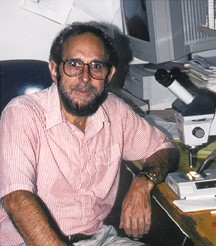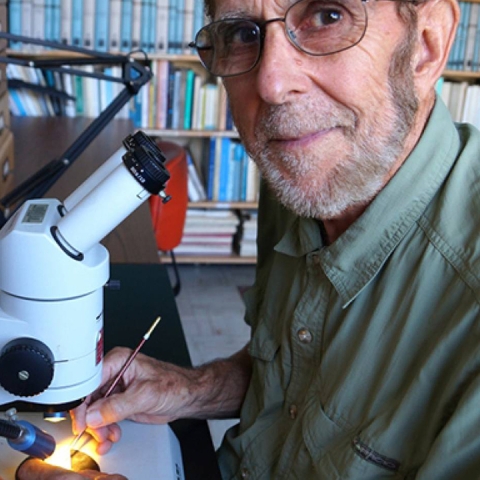
Professor James P. Kennett, a marine geologist on the faculty of the University of California, Santa Barbara, and former director of the university's Marine Science Institute, was elected Tuesday, May 2, to the National Academy of Sciences, considered one of the highest honors that can be accorded a scientist or an engineer.
"I share our colleagues' joy and pride at the election of Professor James Kennett into the National Academy of Sciences," said UCSB Chancellor Henry T. Yang. "Jim's seminal research on marine geology and paleoceanography has significantly advanced knowledge of past climatic, oceanographic and biological changes on earth.
Jim's enormous enthusiasm for science and teaching is a true inspiration to all whom he has touched, and UCSB is greatly honored by this most prestigious recognition."
The award to Kennett brings to 22 the number of members of our outstanding faculty who are members of the National Academy of Sciences.
Bruce P. Luyendyk, professor and chair of the Department of Geological Sciences at UCSB, said, "If the mark of a great scholar is an individual who has created an academic discipline, Professor James Kennett is a great scholar twice over. He has fathered two important disciplines: marine geology and paleoceanography. Dr. Kennett has made tremendous contributions to each of these fields, including over 190 papers and the seminal textbook, Marine
Geology, published in 1982; he founded the leading journal Paleoceanography in 1986. Now, after 30 tremendously productive years, Dr. Kennett has scaled new heights with his recent research on the high resolution oceanographic and climatological history of the Santa Barbara Basin. This research has put UCSB on the map both as a place of scientific discovery and as a campus adjacent to a unique oceanographic laboratory."
Kennett, who was born and educated in New Zealand, received the news of his election to the academy while at sea in the Southern Ocean southwest of Tasmania.
He has been aboard the famous drill ship JOIDES-Resolution* for 48 days now collecting sediment cores from under the ocean which will be analyzed for the clues they can provide to understanding Earth's history and the evolution of life.
The ship will dock in Sidney in two days.
"The science has been terrific, carried out by an international team of 28 scientists and 90 drillers, technicians and crews," said Kennett,
in a telephone conversation with Chancellor Yang today.
The sediments that he is collecting contain tiny marine fossils that hold within their frozen forms secrets of the Earth's distant past.
"The continuous sediment sequences we have cored extend down to 960 meters below the ocean floor are as old as 60 million years," he said. "Basically we have constructed a pretty coherent history of the birth of the Circumpolar Current about 34 million years ago and the succeeding expansion of the Southern Ocean, with its implications for global climate change and biotic evolution."
On this cruise, Kennett is co-chief scientist for "Ocean Drilling Program** 189: The Tasmanian Seaway between Australia and Antarctica: Paleoclimate and Paleoceanography."
Kennett's many contributions include writing for the lay public and appearing before members of Congress to explain the import of the science in which he is engaged. In a 1996 Santa Barbara News Press article following his Congressional testimony, he explained that "marine scientists at UCSB are making vital contributions to our understanding of the ocean and the related workings of the planet."
"One reason for the success of the research is our location at the edge of the Pacific. It provides us with a unique window on the complex relationship between the sea and climate in the form of the Santa Barbara Channel and its deep, bowl-like sediment basin."
"Because of a fortunate accident of geophysical design, the waters of channel and basin respond to--and amplify--even small changes in ocean currents and temperatures. Moreover, they have chronicled these changes over time in the accumulating sediments on the basin floor."
"For example, we recently discovered that these layers of fossil-rich sediments, acting like pages of a textbook of Earth history, contain an exquisitely accurate record of past global warming events. Tantalizingly, the fossils reveal that major changes in the past occurred extremely quickly, within the span of a human life -- or less than a century."
"We can only speculate as to when such rapid climate changes will occur again. But it is surely a question worth pursuing at a time of widespread scientific concern over global climate change."
James Kennett is a world leader in marine geology, paleoceanography and micropaleontology and has been at the forefront of these fields of research for three decades, said Luyendyk. Kennett's contributions have ranged over broad scales of time from the Late Cretaceous (70 million years before present) to the Quaternary (the last 2.5 million years before present), and in space from the poles to the tropics in both hemispheres and in different ocean basins.
"The thread that ties his discoveries together is his fundamental understanding of the evolution of the global environment, the processes involved in causing global change and the effects these changes have on the evolution of life, especially that in the oceans," said Luyendyk.
The National Academy of Sciences (NAS) election was held during the business session of the 137th annual meeting of the academy. Those elected yesterday -- 60 new members and 15 foreign associates from nine countries -- bring the total number of active members to 1,843.
Kennett received his Ph.D. in geology in 1965 from the Victoria University of Wellington, Wellington, New Zealand. That year he became a Scientific Officer with the New Zealand Oceanographic Institution. Before coming to UCSB in 1987 to be professor in the Department of Geological Sciences and director of the Marine Sciences Institute, he served on the faculties of the University of Rhode Island, Florida State University and the University of Southern California.
The NAS is a private organization of scientists and engineers dedicated to the furtherance of science. The Academy was established in 1863 by a congressional act of incorporation, signed by Abraham Lincoln, that calls on the Academy to act as an official advisor to the federal government, upon request, in any matter of science or technology.
*The name JOIDES-Resolution honors its sponsors, the Joint Oceanographic Institutions for Deep Earth Sampling, and the British explorer James Cook's flagship Resolution.**The Ocean Drilling Program, an international partnership of scientific institutions and governments, explores the Earth's history and evolution. The program is funded principally by the U.S. National Science Foundation, with substantial contributions from its international partners.




